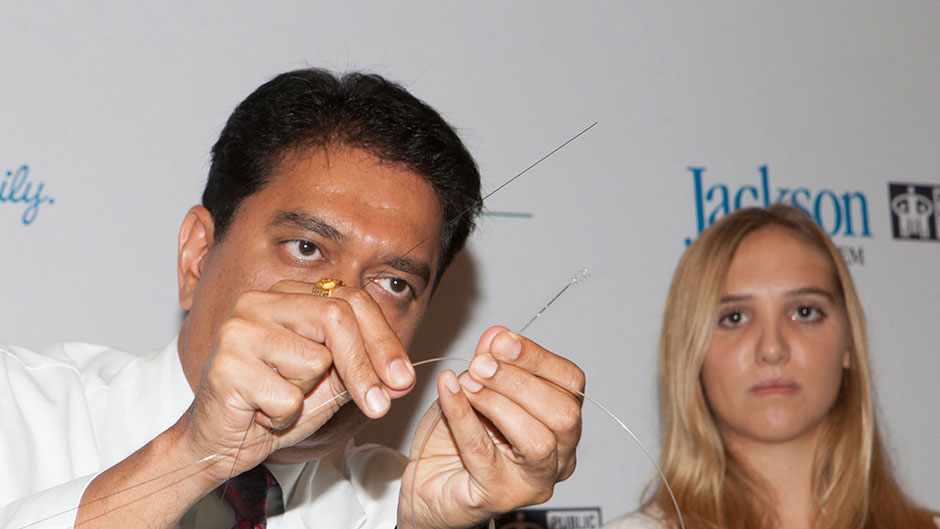A team of stroke experts from UHealth – University of Miami Health System delivered a "game-changing" treatment to 26-year-old Isabel Vinueza at Jackson Memorial Hospital, carefully removing a clot blocking the flow of blood to her brain.
“This team saved my life," Vinueza said at a September 15 news conference. "Nowhere else could I have gotten such fast and effective treatment."
Dileep R. Yavagal, M.D., Chief of UHealth Interventional Neurology, used a stent retrieval device called the Solitaire to clear the blockage in Vinueza's carotid artery. “This thrombectomy procedure is a game-changer that has already changed the standard of care for acute stroke patients," said Yavagal, who led the South Florida component of an international clinical trial. "However, we need to treat patients within six hours of stroke symptoms to be fully effective."
 Since 2007, UHealth physicians have performed nearly 300 thrombectomies. But before the development and approval of Medtronic's Solitaire device, it was more difficult and time-consuming to remove clots, which often would break into smaller pieces. Now, the procedure typically takes 20 to 30 minutes and the entire clot can be removed in one pass. “In Isabel’s case, without Solitaire she would have been left with permanent paralysis and speech deficits, likely needing lifetime assistance,” Yavagal said.
Since 2007, UHealth physicians have performed nearly 300 thrombectomies. But before the development and approval of Medtronic's Solitaire device, it was more difficult and time-consuming to remove clots, which often would break into smaller pieces. Now, the procedure typically takes 20 to 30 minutes and the entire clot can be removed in one pass. “In Isabel’s case, without Solitaire she would have been left with permanent paralysis and speech deficits, likely needing lifetime assistance,” Yavagal said.
Strokes can affect children and young adults as well as seniors, noted Jose Romano, M.D., Chief of the UHealth Stroke Division and Medical Director of the Comprehensive Stroke Program at Jackson. "The key to effective treatment is recognizing the problem and taking the patient to a comprehensive stroke center,” he said. "The sooner we can dissolve or remove the clot, the more brain tissue that can be saved."
On the morning of August 6, Vinueza was cleaning her Brickell apartment when she suffered a stroke. “My right hand and the side of my body were paralyzed, my vision got blurry, and I couldn't really talk,” said Vinueza, who works with her boyfriend Michael Sullivan at The Golden Fig, a new restaurant in Miami.
Fortunately, Sullivan noticed that his girlfriend's face was drooping and that she couldn’t speak clearly – two classic signs of a stroke. He dialed 911, and the responding team of paramedics recognized that she was likely having a stroke and brought her to Jackson Memorial Hospital, whose Comprehensive Stroke Program offers this care round-the-clock.
The Jackson stroke team, led by Amer Malik, M.D., a UHealth stroke neurologist, quickly administered tissue plasminogen activator (IV tPA), an FDA-approved clot-busting medication. However, a CT scan showed a large clot blocking the artery serving the left side of Vinueza’s brain that was unlikely to be dissolved with just medication.
Within 30 minutes of arrival, Vinueza was wheeled into a high-tech angiography suite where Yavagal inserted the Solitaire stent retriever, whose mesh captured the clot so it could be pulled out of her body, instantly restoring the blood supply to Vinueza's brain.
“When I woke up, I could talk, move my hands, wiggle my toes,” she said. “It was the best feeling ever, and I am very grateful to everyone who played a part in my care."

